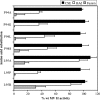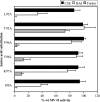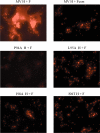Mutations in the stalk of the measles virus hemagglutinin protein decrease fusion but do not interfere with virus-specific interaction with the homologous fusion protein
- PMID: 17626104
- PMCID: PMC2045382
- DOI: 10.1128/JVI.00909-07
Mutations in the stalk of the measles virus hemagglutinin protein decrease fusion but do not interfere with virus-specific interaction with the homologous fusion protein
Abstract
The hemagglutinin (H) protein of measles virus (MV) mediates attachment to cellular receptors. The ectodomain of the H spike is thought to consist of a membrane-proximal stalk and terminal globular head, in which resides the receptor-binding activity. Like other paramyxovirus attachment proteins, MV H also plays a role in fusion promotion, which is mediated through an interaction with the viral fusion (F) protein. The stalk of the hemagglutinin-neuraminidase (HN) protein of several paramyxoviruses determines specificity for the homologous F protein. In addition, mutations in a conserved domain in the Newcastle disease virus (NDV) HN stalk result in a sharp decrease in fusion and an impaired ability to interact with NDV F in a cell surface coimmunoprecipitation (co-IP) assay. The region of MV H that determines specificity for the F protein has not been identified. Here, we have adapted the co-IP assay to detect the MV H-F complex at the surface of transfected HeLa cells. We have also identified mutations in a domain in the MV H stalk, similar to the one in the NDV HN stalk, that also drastically reduce fusion yet do not block complex formation with MV F. These results indicate that this domain in the MV H stalk is required for fusion but suggest either that mutation of it indirectly affects the H-dependent activation of F or that the MV H-F interaction is mediated by more than one domain in H. This points to an apparent difference in the way the MV and NDV glycoproteins interact to regulate fusion.
Figures











References
-
- Alkhatib, G., and D. J. Briedis. 1986. The predicted primary structure of the measles virus hemagglutinin. Virology 150:479-490. - PubMed
Publication types
MeSH terms
Substances
Grants and funding
LinkOut - more resources
Full Text Sources
Research Materials
Miscellaneous

